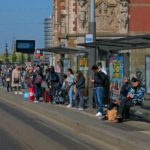 The experience of waiting for services is universally disliked, regardless of whether it involves a lengthy queue at a supermarket or an additional thirty minutes spent in a physician’s waiting room.
The experience of waiting for services is universally disliked, regardless of whether it involves a lengthy queue at a supermarket or an additional thirty minutes spent in a physician’s waiting room.
Recent research from Ohio State University indicates that wait times are not equivalent for all individuals, as Black Americans and lower-income Americans tend to encounter longer wait times. According to the research, the waiting gap has significant implications beyond just stress and loss of productivity.
Prolonged wait times for medical services have been linked to poorer health outcomes, while lengthy queues at polling stations can hinder people’s ability to exercise their right to vote.
The impact of waiting
The researchers analyzed 17 years’ worth of data from the American Time-Use Survey. This data was based on time diaries that were collected by the U.S. Bureau of Labor Statistics. They compared wait times across households with varying income levels and made adjustments for factors such as work and travel time, family responsibilities, education, and demographics.
“The unconditional gap in waiting time suggests low-income people spend at least six more hours per year waiting for services than high-income people,” they explain. “Further, high-income Black people experience the same higher average wait times as low-income people regardless of race.”
“Generally, people understand that we have some agency in how we decide to spend our time. What makes waiting unique is that sometimes you need the service, say medical attention for instance, and can’t just choose not to wait,” they continue. “We show that economic and social inequities create inequities in our autonomy over our own time, and that disadvantaged groups pay a higher price for services in the form of their time.”
The cost of time
Waiting in line is not the only example of income-related time inequity, of course.
Individuals with higher incomes and salaried jobs typically have more flexibility in scheduling appointments during paid work hours, using time-saving services such as food delivery, or hiring someone else to take care of their family responsibilities.
Conversely, those who are low-paid or work hourly jobs may experience income loss when taking time off for necessary medical appointments, child-care, or school obligations, and may need to care for family members themselves. The paper notes that this has implications for gender and racial time inequality, as women and people of color are more likely to be employed in less flexible, hourly jobs.
In addition, lower-income individuals often interact with government agencies for services, which can require substantial time spent on paperwork, waiting in government offices, and dealing with bureaucracy.
The paper also highlights the impact of racism and class discrimination on time poverty, citing research that shows residents of Black neighborhoods waited nearly 30% longer than residents of white neighborhoods in the 2016 presidential election. Black Americans also face challenges in accessing mental health appointments, and those who “sound Black” on the phone may take twice as long to find apartments compared to white-sounding callers.
“The difference in treatment when seeking basic services represents a pernicious inequality in the daily lives of the rich and poor,” the researchers explain. “Beyond the economic effects of imposed unproductive time, additional time waiting for basic services makes predictable daily schedules more difficult, leading to stress and creating spillovers into the quality of time spent in other activities.”
According to the researchers, the reported differences in wait times may actually be underestimated, and there is a need for additional research to better understand the impact of wait times on productivity and civic engagement.
The article also raises the question of whether increasing socioeconomic and racial diversity among public sector employees could lead to greater efficiency and a reduction in wait times.